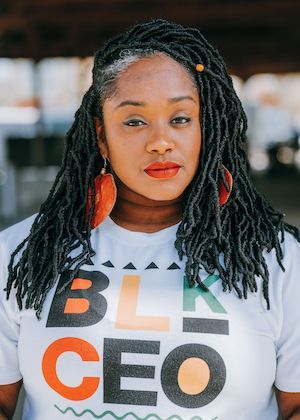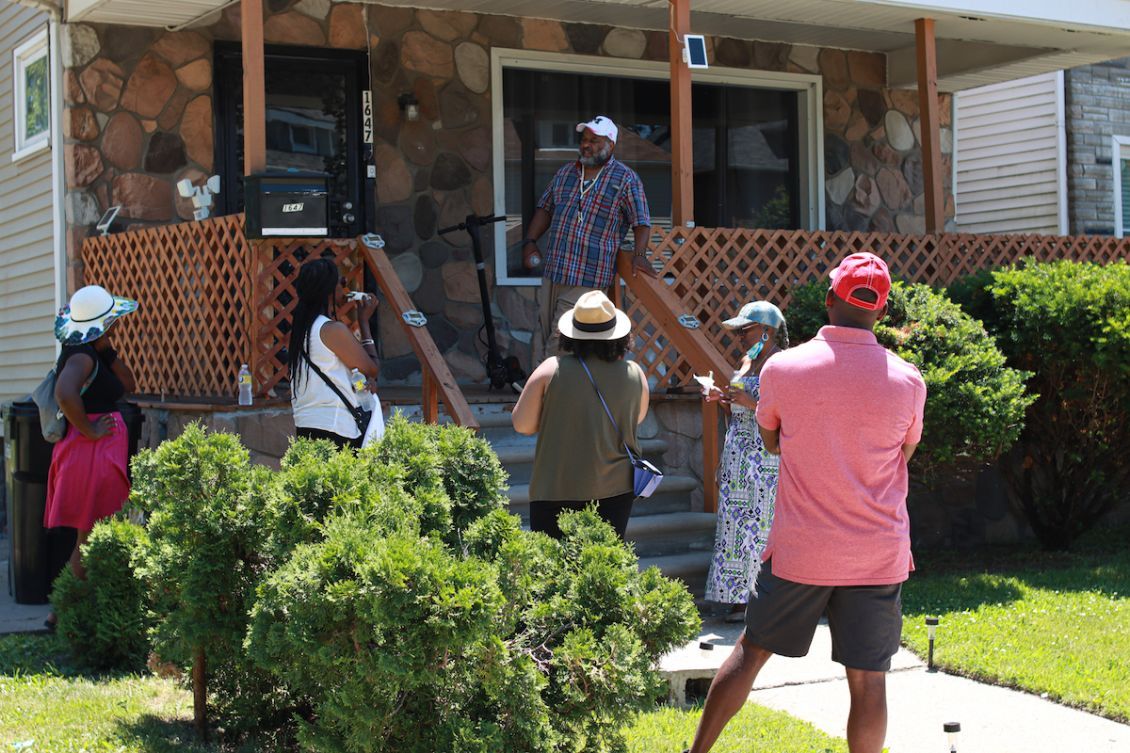They are indispensable in so many neighborhoods in Detroit and in communities across the country: Small grassroots organizations that take on local challenges up close and personal.
Yet they work in a nonprofit paradox: They are closest to the needs but furthest from the resources to provide solutions.
That’s where Michigan Community Resources (MCR) steps in, supporting frontline groups with essential capacity-building services and leading system transformations for the nonprofit sector in Southeast Michigan and beyond.
In 2021, Enterprise partnered with MCR to bring their expertise to our Elevating Community Development Organization (ECDO) Fund, a philanthropic collaborative that delivers critical operating support grants to six Detroit nonprofits that are led by Black, Indigenous and people of color (BIPOC). The ECDO Fund program is supported by grants from the Ford Foundation, Kresge Foundation, Ralph C. Wilson, Jr. Foundation and Hudson-Webber Foundation.
We talked with two MCR principals about their work.
Shamyle Maya Dobbs (she/her) is MCR’s chief executive. She has over 25 years of experience in nonprofit management and has been with MCR for more than 14 years. Shamyle’s passion for social justice and addressing systemic issues facing communities of color motivates her daily.
Matthew Schmitt (he/him) is MCR’s director of resource navigation. He works to design ways nonprofit leaders can serve as ambassadors between organizations and their funders. Matthew’s work also creates opportunities for leaders to demand more equitable access within the landscape of funding opportunities and other resources.
Enterprise (E): Tell us about your work with local nonprofits.

Shamyle Maya Dobbs (SD): Our unique position within the sector of nonprofit intermediaries—nonprofit organizations that support other nonprofit organizations—is that we focus on small nonprofits and grassroots organizations. These groups are often the furthest from key resources, relationships and decision-making tables, although they are nearest to the issues and community need, working on the frontlines toward change.
Capacity building must go beyond serving the needs of individual organizations into removing barriers that prevent these organizations and the communities they serve from thriving. These barriers include lack of access to steady funding and professional services needed to build internal capacity, and structural impediments that impact how stakeholders engage with one another. All barriers that are rooted in racial and social inequity.
These barriers are too large for any one organization to tackle alone, so we’ve embraced organizing, network building and maintaining partnerships across a broad network of stakeholders as essential strategies to achieving this vision. We are aiming to transform broken systems and shift the attitudes, norms and practices that keep nonprofits and communities from thriving by centering racial and social equity as core values and key outcomes in our work.
Matthew Schmitt (MS): MCR comes alongside local nonprofits at any step in their journey. We understand that nonprofit leaders and their teams know their strengths and needs best, and we work to meet them wherever they are. We provide support as nonprofits navigate the steps involved in establishing and maintaining nonprofit status, identifying funding opportunities that align with their missions and staying the course when roadblocks inevitably occur.
As the director of our resource navigation programming, my team and I serve as “ambassadors” between nonprofit leaders and their funders. We work to make space to check in about project development, connect nonprofit to contractors and service providers, and curate opportunities for collaboration and mutual support among nonprofit leaders within a grant cohort.
For Enterprise’s Elevating CDO cohort in Detroit, we support the Enterprise team in building a positive experience for their six grantees.
E: How would you describe an emerging nonprofit, and what is their unique role in the community?
SD: Many organizations, block clubs and community groups that have been around for years still get painted with the label “emerging” due to a lack of outside resources, attention or support. However, true emerging nonprofits can offer a fresh perspective on needs and solutions, as they are newer to the scene.
If we are talking about well-established, unincorporated organizations that are striving to become nonprofits as an often-necessary prelude to receiving grants, I would offer that these organizations are often closest to the issues our sector is working together to solve. They are uniquely positioned to identify needs and barriers to success felt in the communities being served. Their impact and contributions have historically been minimized in favor of larger, whiter institutions.
At MCR, we work to advocate and create space for nonprofit leaders—particularly women and BIPOC leaders—to voice their experiences and receive the recognition and resources they need to achieve their visions for their communities.
E: What are the major challenges for emerging nonprofits?
MS: Emerging nonprofits need respect and trust. As recent as two months ago, I overheard reluctance from a funder to grant $30,000 to an incredible project because “the proposal (was) compelling and clear, but the size of their budget raises concerns that they couldn’t handle a grant this size.” Thirty thousand is a small grant! If the project is well described with evidence that it has been vetted by the community and the people who would be most impacted by it and it would bring tangible positive change, give them the money. How else will nonprofits demonstrate capability if they don’t have the funds to work with?
E: How have the last two years and Covid impacted these nonprofits?
SD: The period in which Covid forced the world to be still and attuned to the happenings around them illuminated what we long understood about our society and its tendency to ignore the insidious effects of white supremacy. The racial uprisings resulting from George Floyd’s murder forced everyone to revisit their thinking and philosophies around diversity, equity, inclusion, racism and discrimination.
The world could no longer ignore the ugly truths. The inequities in the nonprofit sector—rooted in the same systemic oppression that allowed that officer to lay his knee on George’s neck—were finally becoming a real discussion point for change during Covid. Nonprofits led by people of color were thrust into a space of open dialogue and increased opportunities for funding.
Covid itself exacerbated the issues affecting communities and forced already resource-strapped organizations to continue to make difficult decisions that impacted their survival. Ironically, when you are accustomed to “lack,” your already heightened skills around resilience become even more acute.
MS: The events of the last two years forced nonprofits of all sizes—like their for-profit counterparts—to make immediate pivots. Whether it was clearly aligned with their existing missions or not, nonprofit leaders took on tasks like safe grocery gathering and delivery, transportation to health facilities, and advocating for rent payment flexibilities, all to meet the basic needs of their neighbors and constituents.
When everything went virtual, these organizations wrestled with the rampant lack of internet connectivity and increased their door-to-door printed newsletter outreach and worked to get free public wi-fi hotspots installed in parks and other safe gathering places.
Because they know their neighbors, they immediately knew what to do, and they sprang into action. This responsiveness to emerging needs rooted in authentic relationships based in trust earned over time makes the case for continued co-investment in these organizations and leaders!
E: What is the value of a program like the ECDO Fund? How do unrestricted funds and technical assistance help these organizations?
SD: The Elevating CDO Fund is a necessary step in the right direction to undo the harms created over time by systemic inequity and marginalization. The correlation between the needs of community development organizations and their lack of access to philanthropy created a situation where these organizations became over-reliant on resources, mini grants and technical assistance.
When you think of how we define and prescribe technical assistance for community development organizations, it is rooted in the sentiment that there is lacking and need. All organizations and businesses, large and small, require support. However, if you are able to financially support your own needs, the help you are receiving is labeled differently—i.e., consultants, partners, advisors, business mentors, etc.
As such, the Elevating CDO Fund is truly reparatory in nature. It creates a necessary platform to anchor strong and resilient organizations and offer a direct line of access and communication with philanthropy. This dynamic is extremely powerful in reshaping the narrative around capacity building. This is the seed for systems transformation and systemic change.
E: What are the promising practices you're seeing from emerging nonprofits, and from this cohort in particular?

MS: Nonprofit work can make organizations feel isolated from others doing similar work just down the road. But when we make space for leaders to dialogue on shared successes and struggles, we see them organically workshopping with each other.
One organization in the Elevating CDO cohort had multiple people in their community that loved helping with lawn maintenance and yard work, and offered to help other organizations with those services. Many leaders voiced that they needed help with delineation of the responsibilities of staff and board members to best support their missions and to make the most use of their meeting times. Leaders felt relieved to know that others had similar hopes and challenges, so now we are creating a board development workshop series for the cohort.
It’s exciting to see how cohort engagement can demystify nonprofit work while also providing points of connection toward mutual support.
